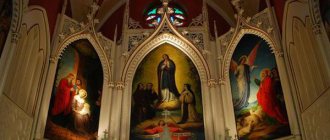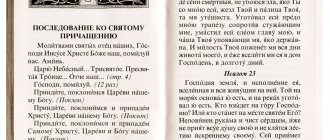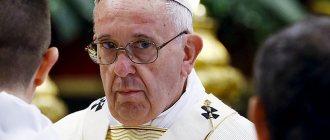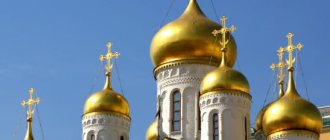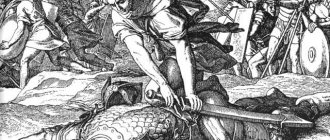Why is the temple consecrated?
The rite of consecration of a religious building is carried out to introduce it into the spiritual world. During the rite of renewal, the religious building is cleansed of worldly influence and becomes a receptacle of Divine Grace. This happens through ancient rites and prayers that call the Lord to His new home.
Important! Church buildings are often compared to a person, who is called a temple not made by hands. This explains the similarity between the rite of consecration and the Sacrament of baptism.
To answer these questions, we should start with the most seemingly obvious... Any first-grader will tell us that an Orthodox church is a place where people pray to God.
The Lord has vouchsafed us to live in a time when church domes can be seen in every district of the city, especially in the center, and moreover, entry to these churches is free for everyone. “But wait,” some will object to us, “is it really necessary: to go to church, stand among the crowd crowding you and at certain moments ask everyone for the same thing? I feel calmer at home, sometimes I’ll light a candle there in front of the icon, I’ll pray in my own words about one thing or another - God will hear me anyway...”
Yes, it is absolutely true that the Lord hears everyone who calls on Him in truth, as stated in the words of the Apostles, but there is a huge difference between these two things.
Rev. Joseph Volotsky in his work “The Enlightener” writes: “It is possible to pray at home - but to pray as in a church, where there are many fathers, where singing unanimously goes back to God, where there is unanimity, and agreement, and a union of love - is impossible.
At this time, O beloved, not only people cry out with a trembling voice, but also angels fall to the Lord, and archangels pray... And Peter was delivered from prison by prayer: “Meanwhile, the church diligently prayed to God for him” (Acts 12:5). If church prayer helped Peter, why don’t you believe in its power, and what answer do you hope to receive?
Therefore, the temple is a place of special presence of God. Yes, we talk about the Creator in prayer to the Holy Spirit, that He “abides everywhere and fills everything with Himself” (“...who is everywhere and fulfills all things...”), however, it is obvious that His presence in a hypermarket, where attention-diffusing music is constantly playing, is noticeably different from being present in the temple, where great praise is being given to Him.
“Let Your eyes be open to this temple day and night, to this place about which You said: “My name will be there,” King Solomon once prayed, having built the first temple for the Lord in Jerusalem (1 Kings 8:29). The bishop pronounces these same words publicly during the rite of the great consecration of the temple. During this sacred rite, something happens that is very reminiscent of the holy Sacraments performed by God over man.
The gates of the altar are closed and not a single candle in the temple is still burning. The priests prepare the throne behind the Royal Doors and, just as nails were driven into the hands and feet of Christ, so they drive them into the four corners of the throne, after which they fill it with an aromatic composition that quickly hardens in the air.
The future Throne is washed with water and wine, consecrated by the bishop’s prayer, mixed with incense, as a sign of memory that from the Wound of Christ, when He was pierced on the Cross by the centurion Longinus, Blood and water flowed out...
The throne is anointed with myrrh - the same oil through which the Holy Spirit descends on all Christians immediately after Baptism. Acquiring the Holy Spirit, according to the word of St. Seraphim of Sarov, is the goal of Christian life. Such anointing is subsequently performed over the walls of the temple. It is surprising that myrrh, prepared exclusively for performing the Sacrament over a person, is used here to sanctify inanimate objects. It is this sacred rite that creates that inexpressible difference between an ordinary building and a temple, the house of the Almighty Lord. Thanks to him, even dilapidated churches desecrated by years of atheism retain this atmosphere of the prayer that was once performed in it...
An important point is that a piece of the martyr’s relics is necessarily placed at the base of the throne. This is a continuity from antiquity: the first three centuries after the Nativity of the Savior, while under persecution, Christians performed their most important sacred rite - the Divine Liturgy - in catacombs and underground burials.
And they certainly did this over the tombs of those who, with their lives, even to death, testified to the incarnate Savior that He conquered death. After all, this is exactly how the word martyr was originally translated from the ancient Greek language - witness.
The logic of the ancients was surprisingly simple and elegant: there is no more worthy place on earth for the Body and Blood of the Lord to reside than the relics of those who suffered for Him. That is why, to this day, the sacred Liturgy is celebrated on the relics of the martyrs, embedded in the base of the throne, and that is why, before that moment of the service when the Cherubic Hymn will be sung and the bread and wine will be transferred from the Altar to the Throne, the priest fully opens the antimension - a special plate lying on the throne, which also contains a piece of the relics of the martyr of Christ. It is here that bread and wine will become the Body and Blood of God incarnate.
The relics, before being laid at the base of the altar, are solemnly carried out by the bishop along with all the clergy from the church and a procession of the cross is held around the newly consecrated church.
The procession stops on the street in front of closed gates, behind which there is only a church choir - these people represent the angelic army, which, seeing Jesus Christ on the day of His glorious Ascension into Heaven, perplexed about the mystery of the Incarnation, asked in the words of the Psalm: “Who is this King of glory? » and heard the answer: “The Lord of hosts, He is the King of glory!” Such a dialogue takes place here, between the bishop and the choristers, in memory of those events.
And only at the end of the ceremony does the bishop light the first candle in the temple, the fire from which spreads to all the other candles. Next, the first liturgy is celebrated, after which the temple begins to live a new liturgical life.
As we see, the consecration of the temple is not only a symbolic action, it also has a very important spiritual meaning. The very place where people gather in the name of the Lord becomes part of the grace of the Holy Trinity. Therefore, just as a person through the Sacrament of Baptism and Confirmation, according to the word of the Apostle Peter, is chosen to be the Lord’s inheritance (1 Pet. 2:9), so the Orthodox church becomes a special place of God’s presence on Earth.
Deacon Daniil Maslov
Photo by Antony Topolova/ryazeparh.ru
CONSECTION OF STONE THRONES
From the collection “Consecration of the Temple” (IS ROC, 2006, pp. 375–380)At the end of the section on the great consecration of the temple by the bishop, we present a Russian translation of the rubric of the Byzantine Euchologies of the 11th and subsequent centuries [1] on the order of constructing a throne made of marble - this rubric should be followed in cases where not a wooden, but a marble throne was built in the temple (otherwise , except for the peculiarities of the device, the rite of consecration of the marble throne is no different from the rite of consecration of the wooden throne):
“One day [before the consecration] [2] the head of ordinations, Hieronymus [3], or someone else who is entrusted with church service, arrives at the indicated temple and instructs the stonemasons to prepare a meal [4] and place it on the pillars, so how it should be erected.
The bishop who came after this takes three particles of the holy relics of the martyrs, which after the sacred rite should be placed, if the meal is supported by pillars, in a kind of tomb prepared at the base between the eastern pillars [of the throne]; if it is supported either by an all-stone [5] or an elevation composed of many stones, then in a reliquary made by a master [6] in the middle of the elevation on the side that faces the mountainous place; and, having put these three particles of relics into a casket, similar to a casket, in which they will lie, he places this box in the holy paten and, placing the so-called star on the paten, covers it with a cover and, having carried it, leaves it in some honest temple located not far [from the one being sanctified]; and here Vespers, night service[7] and matins are celebrated.
After this, Hieronymus or another clergyman again comes in advance and fully prepares the necessary [items], which must be all new and untouched, these include: shrouds, that is, two white shrouds [8]; three ubruses [9], which are boards for the hands; three belts; carpets, in other words – a prayer rug and pillow [10]; vegetable [11] papyri, cut in half or even three times, depending on the thickness of the pillars supporting the meal; sfikomu [12], that is, a thin rope; mastic [13], wax and marble chips; a pot [for heating] [14], a vessel for boiling water, a bowl [for blessing water] or a large jug [15] - copper or clay; four sponges; white soda [16]; a lamp or so-called lamp, lantern, lead tubes [17] and wicks; two jugs: one full of fragrant wine [18] or [plain] wine, the other - myrrh [19]...
So, having prepared this, the clergyman who came in advance orders the wax to be melted in a heated pot and at this time measures out the mastic, just as marble chips are measured - the number of these [components is proportional to] the number and thickness of the columns; He also orders that everything that can be moved be taken out of the temple and that [not a single] lamp should be lit.
When the bishop arrives, the meal is removed from the pillars and placed somewhere against the wall. All the laity are taken out, only the priests and other clergy and ministers remain inside, as well as everything necessary for consecration; and, when the gates are securely locked on all sides of the temple, the bishop is dressed in all bishop's clothes, and the bishops, priests and ministers who are with him put on their clothes.
And for the bishop who is going to perform the consecration, a shroud [20] is placed on top of the sacred vestments, extending from the chest to the feet in front, and held at the back from both edges under the armpits to the back, tied in the middle, covered with a belt; and ubruses [21] tied with belts are placed on each hand.
And, having thus dressed, [the bishop] enters the altar with those accompanying him, and when he orders, they bring vegetable papyrus, which they must cut so that they can wrap it around each of the pillars of the meal; cut off as much as necessary; the upper part of the papyrus, which should protrude above the top of the column, is made double, the short side of the fold is folded inward; the lower [part of the papyrus is left plain]; for hot wax with mastic [22] will be poured on top and the papyrus must be double so that it can hold the wax wax so that it does not spill, and hold it [so that the wax wax is poured] with a thumb along the perimeter of the pillar from above.
So, having wrapped each pillar in papyrus as was said, they tie it around the outside with a rope, wrapping it three times on top and three times on the bottom; then, twisting the ends of the upper and lower turns, they lead [them] around the middle and, crossing them with each other, make the image of a cross between the upper and lower turns; and, stretching it out, tie it from behind.
After this, the upper edges of the pillars are covered with marble chips near the protruding fold of the papyrus, so that the wax oil does not flow out through some small hole, and when the pot is brought, the wax oil is poured onto the pillars until the papyrus is filled to the brim; As it spreads, [the wax paste] cools slightly because it is hot.
The bishop prays like this: “Lord God our Savior, do and build everything for the salvation of the human race.”
And after “Amen,” the bishop, together with those present, take the meal with their hands, calling, if the need arises, even some master [23]; and they place it on the pillars, singing Psalm 141, “I will exalt Thee, my God, my King,” three times, they praise [24] and, having cut off the leaked wax and cleansed the places where it spilled, they sing again - Psalm 22 , “The Lord shepherds me and deprives me of nothing,” at the end of which they glorify; and the bishop proclaims: “Blessed is our God, always, now and ever, and unto ages of ages. Amen".
Then they lightly press the table with their hands from all sides in order to fit it to the pillars and set it up well. This happens if the meal is supported by pillars or even one pillar.
[If the table should rest on an elevation, then] if the elevation located under it has a rectangular shape [and] if the table supported by this [also] turns out to be rectangular, [then] wax is poured onto the four corners and this is how the installation is accomplished.
If the meal should be composed of various [pieces of] marble, then the master builds [everything], except [the middle part, and only] the middle quadrangle is mounted with the help of wax, [the clergy] do not wrap it in papyrus, nor do the other [parts adjust] "
Otherwise, the procedure for consecrating stone thrones does not differ from the procedure for consecrating wooden ones.
] See: The rite of consecration of the temple and the position of holy relics in the Byzantine Euchologia of the 11th century. / Translation, preface and comments by M.S. Zheltov // Relics in the art and culture of the Eastern Christian world / Compiled by A.M.Lidov, M., 2000. pp. 111–126.
[2] Square brackets indicate words that are not in the Greek text and have been added for clarity.
[3] In the Russian Official it corresponds to “klyuchar”, i.e. rector of the cathedral church.
[4] This word refers to the top plate (in the Russian Official - “dska”) of the throne.
[5] Greek μονόλιθος – “monolithic”.
[6] That is builder-mason.
] Greek παννυχίς is one of the services of the cathedral daily cycle of worship in the Church of Hagia Sophia, which, like monastic Compline, took place in the hours following dinner. There was also a monastic παννυχίς, which formed the basis of modern prayer services and memorial services.
[8] Shroud - Greek. σινδόνος - a large piece of simple linen fabric.
] Greek μαντήλιον.
[10] In the Russian Official - “heading”, a pillow for placing under the knees when the bishop reads kneeling prayers.
[11] Thus, the rite excludes the use of parchment, which was made from pigskin; later manuscripts simply talk about paper.
[12] Greek ςφήκωμα – “harness”. The rope is later used both for attaching papyri or paper to the columns of the throne (to pour an adhesive substance - wax paste) into the resulting reservoirs, and for fixing the sarbita.
[13] Mastic was prepared from the mastic tree, Pistacia lentiscus.
[14] In Russian Official - “highlander”.
[15] In Russian Official - “pollator”.
[16] Mineral salt Na2CO3·H2O2, which was found at the bottom of dry lakes. In later manuscripts, “natr” was replaced by “sapun”, i.e. soap.
[17] That is tubes for lamp wicks.
[18] Greek. οἰνάνθος, lit. "wine color" Slavic translators initially left this word without translation: “imaf” (Trebnik RNL. Gilf. 32. L. 169), later Greek and Slavic ranks speak of rose water or wine with the addition of rose water and other aromatic substances.
[19] Missed comment about the number of St. peace and fragrant wine.
[20] In Russian Official - “zapon”, i.e. linen apron; Greek σάβανον – shroud.
[21] Greek. μαντήλια – boards [for hands].
[22] In Russian Official - “wax-mast”. From the rite of consecration of stone thrones, the meaning of the wax mastik is clearly visible, which lies in the fact that the wax mastik serves as a binding substance for the structure (which is not at all clear in the case of the construction of a wooden throne, where the connecting element is nails, and the wax mastik is preserved in the rank only by tradition).
[23] That is not a clergyman, but a lay mason who built the throne. The participation of a lay person is allowed here, since the altar has not yet been consecrated by the anointing of St. peace and the position of St. relics, and the reliable construction of a stone throne is responsible and requires serious skill.
[24] Here the term “to praise” refers to the singing of “Glory, even now.”
Peculiarities of the rite of consecration of a temple by a priest
Until the 17th century, the “rite of consecration” by a priest of a temple was not much different from the “great” ceremony performed by a bishop. Patriarch Nikon drew attention to the abnormal situation regarding the consecration of churches that has created in the Russian Church. In his newly revised Trebnik of 1658, Patriarch Nikon placed only the rite of the great consecration of churches. Fathers of the Moscow Council of 1666/67. approved this decree, which prohibited priests from acting in the consecration of churches in the bishop’s manner, and approved the procedure for the consecration of the temple by the priest, calling it: “The procedure for placing the consecrated antimension in the newly created temple, given from the bishop to the archimandrite, or protopresbyter, ... chosen for this and skillfully” ( Priest V. Prilutsky, op. cit., p. 45).
According to the Trebnik of Peter the Mogila, the consecration of the temple by the priest did not exclude the need to consecrate the temple again by the bishop. This rite was interpreted as a temporary means to, without waiting for the episcopal consecration of a certain church, to make it possible to perform the liturgy in it “for the time being.” But as soon as the bishop had the opportunity to be in such a church, it was consecrated again, with the full rite of episcopal consecration of churches (See Preface to the Rite. Breviary of P. Mogila, part II, p. 74).
The rite, compiled by Metropolitan P. Mogila, is a product of his own liturgical creativity. The drawing up of the rites resolved an important liturgical and practical issue. According to his order, the priest no longer acted during the consecration of the temple in the bishop’s manner, that is, in creating the order of consecration of the temple by the priest, he followed the path that the North Russian Church took after Patriarch Nikon (Priest. V. Prilutsky. Ibid., p. 66).
When consecrating a church, the most important and essential part is the consecration of the antimension, which can only be performed by the bishop. This consecration is what is meant in the Trebnik when it says: “There are three actions, from which not a single priest, except the bishop himself, can perform. First: sanctification of the world; second: the consecration of the altar and temple; third: ordination of the priesthood” (Bolsh. treb., g. 107). The priests consecrate the temple, with the blessing of the bishop. Therefore, from the priestly rite of consecration of the temple everything that is connected with the consecration of the antimension is excluded. And the rite itself is distinguished by less solemnity and is much shorter in comparison with the bishop’s rite in terms of the number of prayers and sacred rites included in it. Features of the rite of consecration of a temple by a priest are as follows:
1. On the eve of the day of consecration, in front of the icon of the Savior at the royal gates, a paten with a consecrated antimension, covered with a star and air, is placed on a lectern. A candle is lit in front of him. In the altar, on a special table near the high place, sprinklers and stones for nailing are placed.
2. Prayers for the confirmation of the throne, read by the bishop during the consecration of the antimension, are not read.
3. According to the order set forth in the Great Breviary, the throne and walls of the temple are not anointed with holy myrrh, because Confirmation has already been performed by the bishop over the antimension.
4. The lower throne garment (srachitsa) is tied around the throne like a belt, and not crosswise.
5. During the procession of the cross around the temple, they carry not a paten with relics, but an antimension with holy relics embedded in it.
6. Words: “Take, O princes, the gates are yours” and “Who is this King of glory?” before the closed doors of the temple are pronounced only once.
7. Holy relics are not placed under the altar; only the antimension rests on it. After this, the kneeling prayer is read: “Lord our God.”
8. After reading this prayer, there is a small litany (there is no service), and the priest makes the sign of the Cross three times on four sides. At this time the choir sings: “Lord, have mercy.”
9. When kissing the Cross, the priest sprinkles holy water on those present. Many years are not sung.
Then, as after the bishop’s consecration of the temple, the hours are read and the Divine Liturgy is celebrated.
Small consecration of the temple
The bishop and priestly rites of consecration are called the “great consecration” of the temple. This consecration is performed not only over a newly built temple, but also in cases where for some reason the altar is damaged or moved.
If the throne was not moved from its place or damaged, but the inviolability and holiness of the throne were somehow violated, then, with the blessing of the bishop, there is a special renewal of the temple with prayer and sprinkling of holy water so that, according to the words of Moscow Metropolitan Cyprian, “seducless sacred service in the temple” was performed. This renovation of the temple is called the “small consecration” of the temple.
Minor consecration is performed, firstly, in the case when an unconsecrated person touches the throne, its sacred utensils and clothes (For example, in the event of a threat of fire or other disaster). In the Old Testament, Nadab and Abihu were punished by death for putting wonderful fire into their censers (Lev. 10:1). Uzzah was struck to death for touching the Icon of the Covenant (2 Kings 6:6-7). As in the Old Testament Church, in an Orthodox church only the chosen ones can touch the throne (Lev. 10:3).
During a small consecration, they usually sing a prayer service to the saint in whose name the temple was built, i.e. the canon of the temple holiday is sung. A prayer service is held in the middle of the temple. After the minor consecration of the water, two “prayers for the renewal of the temple” are read (Treb. Large. Ch. 93), accepted as part of the rite of the minor consecration of the temple from the Patriarch of Constantinople Callistus, who lived in the last half of the 14th century. The first of these prayers: “Lord our God,” is the same one that is read at the initial consecration of the temple.
Secondly, the minor consecration of the temple is performed after the desecration of the temple by heretics and pagans. If in general an uninitiated person is not allowed, according to the charter of the Church, to enter the altar and especially to touch the shrine of the altar, then the shrine is all the more desecrated by the touch of heretics and pagans (Num. 3:10; Ps. 79:1), when they forcibly take possession of the temple, they trample it underfoot, touch its utensils, or perform their service in it. In this case, during the consecration of the temple, special prayers are read “for the opening of the temple” (Churches in which it is forbidden to serve are called “prisoners”; the expression: “to open the Church” means to allow priests to serve in it (New Skr. Part IV. Chapter 24 , §5),
namely the prayer “for the opening of the Church, desecrated by heretics” (Great Trek. Ch. 41) and the prayer “for the rejection of the temple, defiled by tongues, and also from heretics” (Great Trek. Ch. 41). The rite of consecration of churches from desecration by heretics and pagans was compiled by the holy fathers Nicephorus the Confessor and Tarasius, patriarchs of Constantinople in the 8th century, champions of Orthodoxy against the iconoclasts.
Thirdly, minor consecration of a temple occurs after its desecration by the violent death of a person in it or human blood; birth or death of an animal in it. according to the law of Moses, unclean and unsacrificial. For death is a consequence of sin and birth, as a conductor of sin, is unclean and desecrating (Num. 19; Lev. 12). The Great Trebnik contains a special prayer (chapter 42), “for the opening of the temple, in which a person will die in need” (i.e., a violent or sudden death). The same prayer is read, as stated in the Breviary, when “the church is defiled by death, or the birth of an animal in it.” The Trebnik says about this prayer that it is “spoken at the entrance before usual,” i.e. is said at the entrance to the temple before the prayers usually said by the priest at the entrance to the temple before the liturgy.
The Holy Church considers any desecration of the temple to be punishment for our sins, and therefore, when renovating the temple, it asks for mercy on us and to renew our spirit.
Following the rank at the foundation of the temple
Each cross and the Gospel.
Deacon: “Bless, Master.”
Bishop: “Blessed is our God...”
Chorus: “Heavenly King...”
The formation of ditches, clergy, people and again the Gospel.
Reader: “the usual beginning”, “Come, let us worship...” (three times), Psalm 142: “Lord, hear my prayer...”, “Glory, even now,” “Alleluia” (three times).
Deacon: “Let us pray to the Lord in peace” with special petitions adapted to the subject of prayer.
Chorus: “God the Lord...” and troparia.
Reader: Psalm 50 – “Have mercy on me, O God...”.
Blessing of water and oil.
Sprinkling holy water on the place where the cross will be erected, with the prayer: “Bless, Lord Jesus our God, with the terrible sign and power of Your Cross...”.
The erection of the cross with the singing of the troparion of the 2nd tone: “The cross was erected on the earth, it fell and did not require the vacillation of the enemies...”.
Prayer before the erected cross: “Lord God, the Almighty, prefiguring with the rod of Moses the Honest and Life-giving Cross...”.
Choir: Psalm 83 – “How beloved is Your village, O Lord...”, “Glory, even now” and “Alleluia” (three times).
Deacon: “Let us pray to the Lord.”
Chorus: “Lord, have mercy.”
The bishop reads a prayer over the stone.
Sprinkling the stone with blessed water with the words: “This stone is blessed by sprinkling sacred water on the unshakable foundation of the temple...”.
Placing the relics in the foundation stone.
The bishop laying a stone in the ditch with the words: “This church is founded in the glory of the Great God and our Savior Jesus Christ, in honor and memory (the name of His feast day, or the Mother of God, or a temple saint), in the name of the Father and the Son and the Holy Spirit. Amen".
Pouring oil on a stone.
Choir: stichera 6th tone - “Jacob rose up in the morning and took up a stone...”.
If the foundation of a wooden church is being consecrated, the bishop, taking an ax, hits it three times on the middle altar log with the words: “This work begins in the name of the Father and the Son and the Holy Spirit, in honor and memory of (the name of the holiday or saint). Amen".
Sprinkling the foundation of the temple on four sides, starting from the north, against the sun with the singing of psalms: 86, 126, 121 and 131, reading a special prayer and repeating on each side three blows with an ax to the middle log with the above words.
Singing in front of the erected cross, facing the east, prayers invoking the Holy Spirit “To the Heavenly King...”.
Deacon: “Let us pray to the Lord.”
Chorus: “Lord, have mercy.”
Bishop - prayers: “Lord our God, who has slain in this place...” and kneeling: “We praise Thee, O Lord God of hosts...”.
Deacon - a special litany: “Have mercy on us, O God, according to Your great mercy...”.
The bishop’s exclamation: “Hear us, O God...”
Dismissal of the usual "temple".
Ceremony for founding a church
The foundation and construction of a temple can only be carried out by the ruling bishop of the church region or a priest sent from him.
Anyone guilty of building a church without the bishop's blessing is subject to certain punishment as someone who despises episcopal authority. After laying the foundation for the temple, the “Ordinary for the foundation of the temple” is performed - all together called the laying of the church. At the site of the future Throne, according to the instructions of the Trebnik, a wooden cross prepared in advance is placed.
The foundation of the church (if it is stone) is arranged as follows.
1. Ditches are dug along the perimeter of the future temple.
2. Prepare building materials: stones, lime, cement and others necessary for laying.
3. A special stone is prepared, which has a quadrangular shape. A cross is carved or depicted on it.
4. Under the cross (at the request of the bishop) there may be a place for enclosing holy relics, and in this case a mortgage inscription is made: “In the name of the Father and the Son and the Holy Spirit, this church was founded in honor and memory (the name of the holiday or the name of the temple saint is indicated) , under the Patriarch of Moscow and All Rus' (his name), under the holiness of the Most Reverend (the name of the bishop and his city), and the essence of the relics of the saint (his name) were placed.
In the summer from the creation of the world (such and such), from the Nativity according to the flesh of God the Word (year, month and day).”
The foundation of a temple can be completed without the placement of the relics of a saint and a mortgage inscription. If the church is wooden, then instead of ditches, two holes are dug: for laying a quadrangular stone under the future altar apse and for installing a cross in place of the Throne. Logs for the foundation must also be prepared.
The ceremony for the foundation of the temple can be performed in two ways.
1. Abbreviated rite according to the Great Book of Breviaries.
2. Order according to the Additional Breviary.
Before performing the rite according to the Additional Breviary, the bishop or priest, if he is performing the rite, puts on all the sacred robes of his rank. The religious procession begins when the bishop (or priest) goes to the foundation site of the temple, accompanied by the entire clergy. The bishop (or priest) is preceded by two deacons with censers, priests with crosses, the choir sings lithium stichera for the holiday or saint in whose honor the temple will be founded. At the place of the bookmark, a table with the Gospel and a cross is placed in advance.

